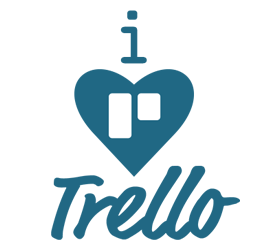We Heart Trello

Agile project management software. Neat little colored digital cards moving left to right. To do, in progress, done. Backlogs, teams, and burndown charts. Flurries of emails – sometimes useful, sometimes not, often routed to folders and never read.
Up until recently, most of us made exclusive use of feature rich tools like Jira, Pivotal Tracker, or Assembla. If you are a developer, tester, pm, or stakeholder in today’s world, you probably still use one of these tools every day. In fact, you are probably so familiar with your particular task management tool that it seems like a natural extension of your work. A job doesn’t feel done until it’s corresponding card is marked, reassigned, and/or dragged and dropped.
In the last year, a new tool called Trello by Fog Creek caused disruption in the Agile Task Management ecosystem. You’ve almost certainly run into Trello by now. Some people have heralded it as a replacement for other Agile project management tools. It is intuitive, elegant, fun to use, and feature poor. I’ll say it again, it is feature POOR. The service doesn’t do a lot, and it would be easy for a competitor to rebuild Trello in a few months.
The funny thing, it is this very lack of features that makes Trello great.
At Grio, we love Trello. This means that we use it whenever we can get away with it. We found that Trello is great for teeny tiny projects and for ongoing admin/committee/department work involving 1-8 people. And that’s it. For our real projects we would never use this thing, because it doesn’t do enough. But that’s ok, because Jira (our fully-featured management tool of choice) is awful for the same types of things that Trello is great at.
As an example of “admin/committee/department work” and our use of Trello, we have this thing called the “Quality Committee” (I know cheesy name) which is responsible for collecting innovative ideas that can help our business and for putting those ideas into practice. The quality committee meets regularly and uses Trello to assign work to committee members. Cards from the previous meeting are reviewed and archived every time the group meets, and if any cards are left in active columns, responsible committee members are ruthlessly shamed and scolded.
When the Quality Committee meets, we project Trello right up onto the monitor. Remote participants have it up on their screens at home. Unlike Jira and Assembla, there is no need to refresh the screen in order for remote people to see changes we are making to the board in the office. This makes it a perfect tool for collaboration. Trello becomes a natural part of the discussion. Jira is much less effective for real-time collaboration, and there are too many features that get in the way. Why should the quality committee need to pick a card type, or to worry choose between “closed” vs “resolved”? Do we really want spend time rooting around in the labyrinth of Jira’s admin section if we want to create another column type called “on hold” (Trello can do this in one click!).
Again, we would never use Trello on our real projects, where we need stories, subtasks, card types, sprints, backlogs, burndowns, estimates, target releases, access control, etc. But it’s Trello’s very lack of features that make it great. The interface is superb, and anyone can learn to use it in seconds.
I’m going to make a prediction: in 2 years Trello will have a lot more features, and in 2 years Trello is going to suck. In fact, this process is already underway. Trello was built to support plugin development and integration, and there are now ways to make Trello act more like Jira, integrating it with Scrum, time tracking, and who knows what else.
It often happens this way with software.
1) Something great comes along.
2) The great thing gets popular.
3) A few people start noticing what the great thing doesn’t do.
4) Whoever makes the great thing starts adding features.
5) The great thing becomes a confused pile of shit.
Don’t blame Fog Creek if they end up following this tired pattern. Like I said, it would be easy to rebuild the service, and I’m sure they are feeling the pressure to add features in order to innovate and retain customers.
However, I hope Fog Creek realizes that it’s Trello’s very simplicity that makes it popular. Trello doesn’t compete with other more mature task management tools, it complements them.

Pingback: Online Agile Project Management Tools - Infoware Studios | Infoware Studios